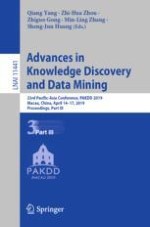The three-volume set LNAI 11439, 11440, and 11441 constitutes the thoroughly refereed proceedings of the 23rd Pacific-Asia Conference on Knowledge Discovery and Data Mining, PAKDD 2019, held in Macau, China, in April 2019.
The 137 full papers presented were carefully reviewed and selected from 542 submissions. The papers present new ideas, original research results, and practical development experiences from all KDD related areas, including data mining, data warehousing, machine learning, artificial intelligence, databases, statistics, knowledge engineering, visualization, decision-making systems, and the emerging applications. They are organized in the following topical sections: classification and supervised learning; text and opinion mining; spatio-temporal and stream data mining; factor and tensor analysis; healthcare, bioinformatics and related topics; clustering and anomaly detection; deep learning models and applications; sequential pattern mining; weakly supervised learning; recommender system; social network and graph mining; data pre-processing and featureselection; representation learning and embedding; mining unstructured and semi-structured data; behavioral data mining; visual data mining; and knowledge graph and interpretable data mining.
